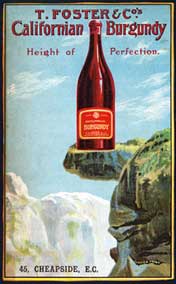History of California wine
History of California Wine[edit | edit source]
The history of California wine is a rich tapestry that dates back to the 18th century when Spanish missionaries planted the first vineyards. Over the centuries, California has grown to become one of the world's leading wine producers, known for its diverse range of wines and innovative winemaking techniques.
Early Beginnings[edit | edit source]
The origins of California wine can be traced to the late 1700s when Spanish missionaries established the first vineyards to produce sacramental wine. The Mission grape, also known as the Criolla or Pais, was the first variety planted in California.
19th Century Expansion[edit | edit source]
The California Gold Rush of 1849 brought an influx of settlers, which increased the demand for wine. This period saw the establishment of many vineyards and wineries, particularly in the Napa Valley and Sonoma County.
Prohibition and Recovery[edit | edit source]
The Prohibition era (1920-1933) severely impacted the California wine industry, leading to the closure of many wineries. However, some survived by producing sacramental wine or grape juice. After Prohibition, the industry slowly recovered, with a focus on quality improvement and innovation.
Modern Era[edit | edit source]
The 1976 Judgment of Paris wine tasting event was a turning point for California wine, as it demonstrated that California wines could compete with the best French wines. This event helped to elevate the status of California wine on the global stage.
Wine Regions[edit | edit source]
California is home to several renowned wine regions, each with its unique climate and soil conditions. The most famous regions include Napa Valley, Sonoma County, Paso Robles, and Santa Barbara County.
Varietals[edit | edit source]
California produces a wide variety of wines, including Cabernet Sauvignon, Chardonnay, Merlot, Zinfandel, and Pinot Noir. The state's diverse climate allows for the cultivation of both Bordeaux and Burgundy varietals.
Related Pages[edit | edit source]
Search WikiMD
Ad.Tired of being Overweight? Try W8MD's physician weight loss program.
Semaglutide (Ozempic / Wegovy and Tirzepatide (Mounjaro / Zepbound) available.
Advertise on WikiMD
|
WikiMD's Wellness Encyclopedia |
| Let Food Be Thy Medicine Medicine Thy Food - Hippocrates |
Translate this page: - East Asian
中文,
日本,
한국어,
South Asian
हिन्दी,
தமிழ்,
తెలుగు,
Urdu,
ಕನ್ನಡ,
Southeast Asian
Indonesian,
Vietnamese,
Thai,
မြန်မာဘာသာ,
বাংলা
European
español,
Deutsch,
français,
Greek,
português do Brasil,
polski,
română,
русский,
Nederlands,
norsk,
svenska,
suomi,
Italian
Middle Eastern & African
عربى,
Turkish,
Persian,
Hebrew,
Afrikaans,
isiZulu,
Kiswahili,
Other
Bulgarian,
Hungarian,
Czech,
Swedish,
മലയാളം,
मराठी,
ਪੰਜਾਬੀ,
ગુજરાતી,
Portuguese,
Ukrainian
Medical Disclaimer: WikiMD is not a substitute for professional medical advice. The information on WikiMD is provided as an information resource only, may be incorrect, outdated or misleading, and is not to be used or relied on for any diagnostic or treatment purposes. Please consult your health care provider before making any healthcare decisions or for guidance about a specific medical condition. WikiMD expressly disclaims responsibility, and shall have no liability, for any damages, loss, injury, or liability whatsoever suffered as a result of your reliance on the information contained in this site. By visiting this site you agree to the foregoing terms and conditions, which may from time to time be changed or supplemented by WikiMD. If you do not agree to the foregoing terms and conditions, you should not enter or use this site. See full disclaimer.
Credits:Most images are courtesy of Wikimedia commons, and templates, categories Wikipedia, licensed under CC BY SA or similar.
Contributors: Prab R. Tumpati, MD



